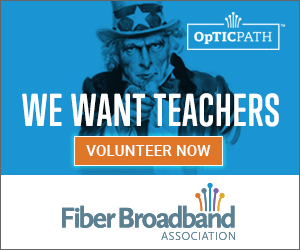Bringing Broadband to America’s Unserved and Underserved
More than 25% of American households do not have a home broadband connection.
That’s according to EducationSuperHighway COO Jack Lynch. Lynch joined a recent Fiber for Breakfast to discuss the current state of the digital divide and how fiber providers can take advantage of the available programs geared towards closing it.
EducationSuperHighway began in 2012 with a mission of bringing high-speed Internet to classrooms across America. At the time, only 12% of classrooms had access to high-speed broadband. Fast forward to 2020, and that number jumped to 99%.
As the pandemic hit, Lynch and EducationSuperHighway realized their mission needed to change. With students needing access to remote school systems at home, EducationSuperHighway set its sights on bringing broadband to America’s most needy communities.
“There were 15 million students that didn’t have Internet access at home,” Lynch stated. “Some of these students were completely shut out from learning during the pandemic. Others had to take extraordinary measures to log-in for school.”
Lynch recalled stories of students sitting outside of fast-food restaurants that offered free Wi-Fi just so that they could attend that day’s virtual lessons.
“Some families in America–as a result of their own connectedness–are being shut out of basic opportunities like education, remote work, health care, job training and access to a social safety net,” Lynch said.
He went on to share that out of the 28.2 million American households without high-speed Internet, 18.1 million have access to a broadband service, but are unable to afford it.
A silver lining that came from the coronavirus pandemic, Lynch noted, was the new political will to address the digital divide, as seen in the recently passed Infrastructure Bill and its $65 billion allocation for fiber buildouts.
“The big difference between the current round of broadband funding and past efforts is that federal policymakers have put a huge emphasis on affordability and adoption of broadband service, as opposed to solely focusing on expanding infrastructure,” he said.
Current broadband funding opportunities are seen in the form of the Broadband Equity, Access and Deployment Program, the Emergency Broadband Benefit and affordable connectivity programs, the COVID Capital Projects Fund, and the Digital Equity Act.
EducationSuperHighway seeks to achieve its mission of bringing broadband to Americans who cannot afford their current offerings through three action items:
- By helping public institutions understand which households are unconnected and serviceable,
- By offering affordable connectivity program service plans and streamlining enrollment, and
- By building fiber to low-income-serving multi-dwelling units and provide affordable connectivity for tenants
Hear Jack Lynch’s full presentation on the Fiber for Broadband podcast.
